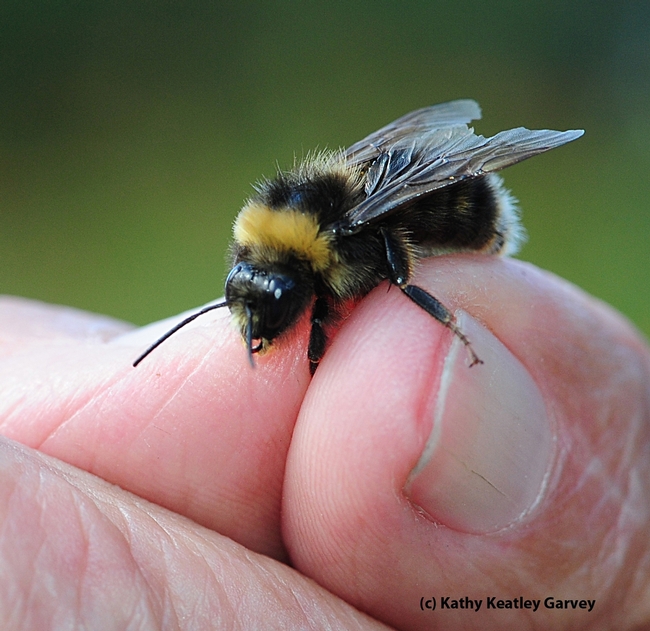By Penny Pawl, UC Master Gardener of Napa County
When you are planning your summer garden, remember the pollinators. Bees and other pollinators are in trouble in California and across the U.S. and need our help. They are nectar feeders so put in plenty of blooming plants for them.
Without pollinators we would lose many food crops. There are 1,000 species of California native bees. Twenty-six of these are bumblebees and most of the rest are solitary bees.
The pollinators native to our area have evolved with the native landscape so it's important to have some native plants in your garden. Pollinators include native bees and butterflies. Honeybees are not native to the United States but were introduced for their honey. However, other pollinators are just as effective. Let me introduce you to some of our native bees.
For several years, I have created nests for the native mason bees. These nests consist of pieces of wood with 3/8-inch holes drilled into them. The one they visit most is a piece of firewood. Mason bees have nested in it repeatedly. I know they were there because of the mud in each hole.
Last year I actually saw the bees leaving their nests and then returning. They are about to come out this spring to pollinate the fruit trees. They don't spend much time flying around before they start building new nests for their babies.
The mason bee creates its nest in long narrow tunnels within the wood. The bees do not make these tunnels; they find them and move in. So I drilled the holes for them. The bees pack the holes with pollen, lay an egg, pack in more pollen and lay another egg. They put three to five eggs per hole depending on the depth. When they are done laying, around the first of April, they seal the holes with mud. I know the nest is full when I see mud in every hole. The eggs hatch the following spring.
This year I did not move the nest to a sheltered location. It appears that woodpeckers have tried to drill out the nest. I will wait and see how much damage the birds have done by the end of March.
I have bumblebees in my garden every year. They especially love my ‘Hot Lips' salvia from Mexico. They spend all day gathering nectar and are gentle.
Bumblebees nest in the ground. You should always leave a cleared area in your garden for them; they will not nest in mulch. I often find their little mounds. When they are done digging, you cannot tell they were even there. They love one particular area of my garden that I always keep clear of mulch.
I also see a lot of carpenter bees, the big bees that drill for nectar in the back of the flower. They are gentle and you can observe what they are doing easily.
They can be destructive when they drill into untreated lumber. I had them in my hothouse one year. They had drilled all the way to the end of a 12-foot-long 4 x 2 board. I had to replace that wood and paint it with latex to keep them out. Putting steel wool in the holes will also stop them. They do need a place to lay their eggs, however.
The male carpenter bee is a big brown teddy bear. He has only one purpose: to pursue females. He does not sting. I had a visit from one a few years back and he hung around me for a while. Once their mating duty is done, they die.
Digger bees and squash bees both nest in the ground. Squash bees emerge to pollinate squash and gourds. They are only present when these plants are in bloom. Even so, I hand-pollinate my squash to make sure I get fruit.
Bumblebees are said to buzz tomatoes, which are self-pollinating. Just to be sure the flowers do pollinate, I shake the vines every morning when I do my walk-through.
To lure pollinators to your garden, plan to have a variety of plants blooming every month of the year.
Workshop: UC Master Gardeners of Napa County will hold a workshop on “Growing Tomatoes” on Saturday, April 6, from 9:30 a.m. to 11:30 a.m. at University of California Cooperative Extension, 1710 Soscol Avenue, Napa.
Join our experienced tomato growers for tips and tricks on cultivating perfect homegrown tomatoes. Learn the latest research on tomato cultivation and care, and discover new and heritage tomato varieties. You'll get all the information you need to grow delicious and beautiful tomatoes in your own large or small garden or in containers. Growing America's favorite garden fruit is not only fun and easy, but also the best way to acquire healthy food for you and your family. Online registration (credit card only); Mail-in/Walk-in registration (check only or drop off cash payment).
Master Gardeners are volunteers who help the University of California reach the gardening public with home gardening information. U. C. Master Gardeners of Napa County (http:/napamg.ucanr.edu) are available to answer gardening questions in person or by phone, Monday, Wednesday and Friday, 9 a.m. to Noon, at the U. C. Cooperative Extension office, 1710 Soscol Avenue, Suite 4, Napa, 707-253-4143, or from outside City of Napa toll-free at 877-279-3065. Or e-mail your garden questions by following the guidelines on our web site. Click on Napa, then on Have Garden Questions? Find us on Facebook under UC Master Gardeners of Napa County.


